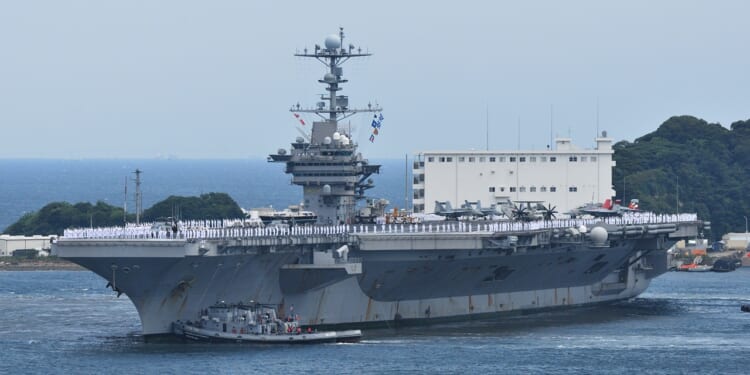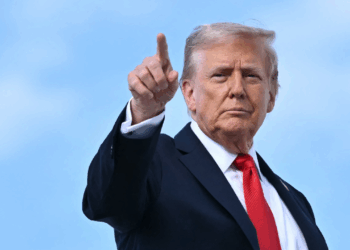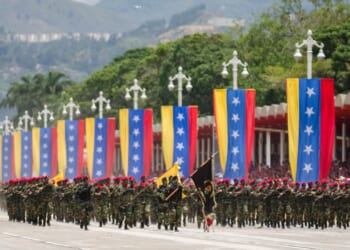North Korea criticized the deployment of the USS George Washington to Busan, claiming that it represented an “anti-North Korean military demonstration” and threatening retaliation.
The United States Navy’s USS George Washington (CVN-73), the only forward-deployed aircraft carrier, arrived in the South Korean city of Busan on Wednesday, joined by the Ticonderoga-class cruiser USS Robert Smalls (CG-62) and the Arleigh Burke-class Aegis guided-missile destroyers USS Milius (DDG-69) and USS Shoup (DDG-86).
Prior to the port visit, the US Navy warships participated in joint exercises with the Japan Maritime Self-Defense Force (JMSDF) destroyer JS Haguro (DDG-180) in the East China Sea.
The Nimitz-class nuclear-powered supercarrier last visited South Korea more than a decade ago, before she returned to the United States to begin the lengthy Refueling and Complex Overhaul (RCOH). It also marked the first visit of a US Navy carrier strike group (CSG) since South Korean president Lee Jae-myung took office in June.
“The arrival of the 5th Carrier Strike Group will serve as an opportunity to enhance exchanges and cooperation between the ROK-U.S. navies and further solidify the combined defense posture,” the US Navy announced.
North Korea Is Watching the Carrier Visit Closely
The last US Navy aircraft carrier to visit South Korea was the USS Carl Vinson (CVN-70) in March of this year, and the port visit was met with condemnation from North Korea.
Kim Yo-jong, the sister of North Korean leader Kim Jong-un, warned that such visits were seen as an “anti-North Korean military demonstration” and stated, “North Korea will be naturally compelled to renew its records in the exercise of strategic deterrence.”
Busan is located approximately 200 miles (320 km) southeast of the capital, Seoul. It is South Korea’s primary port and home to the naval base that serves as the headquarters of the Republic of Korea’s fleet. Busan frequently hosts US naval vessels to bolster a combined defense posture between South Korea and the United States.
The city was also one of the few areas of South Korea that never fell under occupation during the Korean War. Then known in the West as Pusan, it briefly served as the country’s de facto capital before Gen. Douglas MacArthur’s amphibious landing at Inchon.
About the USS George Washington
CVN-73 is the fourth warship named for the Founding Father and first American president. USS George Washington had previously served as the Forward-Deployed Naval Forces-Japan (FDNF-J) carrier, beginning in 2008, also making it the first nuclear-powered warship to fill that role. She was relieved by USS Ronald Reagan (CVN-76) in 2015, which served as the FDNF-J until last year.
During the summer of 2024, the two Nimitz-class supercarriers conducted a “hull swap” in San Diego, when the ships’ two crews traded places.
The change in FDNF-J was not only carried out due to CVN-73 needing to undergo the RCOH. Instead, it was due to Title 10, Armed Forces, Chapter 863, Naval Vessels, Section 8690, which required the “change of guard” with the carriers, as the law passed by Congress limits the length of time a US Navy vessel can be forward deployed overseas to just 10 years. After that period, all warships must be assigned to a homeport in the United States. The rule was implemented for several reasons, including ensuring the readiness of the ships, mitigating the strain of extended overseas deployments, and facilitating major maintenance to be carried out in the United States.
USS George Washington arrived in Yokosuka in November 2024 after sailing from Norfolk, Virginia, after completing the RCOH, and her crew spent much of the first half of the year settling into its new homeport and completing preparations for future patrols.
In late October, President Donald Trump delivered remarks from the deck of the George Washington to US sailors while the ship was in its homeport of Yokosuka, Japan, during his visit to the Far East.
About the Author: Peter Suciu
Peter Suciu has contributed over 3,200 published pieces to more than four dozen magazines and websites over a 30-year career in journalism. He regularly writes about military hardware, firearms history, cybersecurity, politics, and international affairs. Peter is also a contributing writer for Forbes and Clearance Jobs. He is based in Michigan. You can follow him on Twitter: @PeterSuciu. You can email the author: [email protected].
Image: Shutterstock / viper-zero.


















